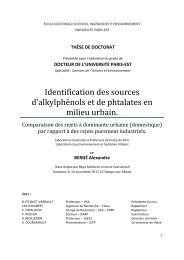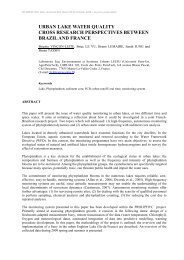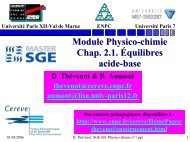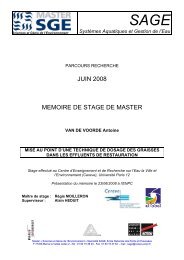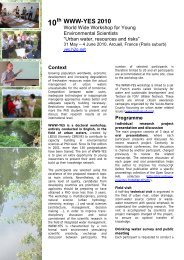View - ResearchGate
View - ResearchGate
View - ResearchGate
You also want an ePaper? Increase the reach of your titles
YUMPU automatically turns print PDFs into web optimized ePapers that Google loves.
problem is a process that was developed in France and then having been exported to be testedin Berlin. We see therefore an innovation developed by Veolia, a global player, with a localapplication and therefore benefiting the city of Berlin. There is therefore the overalldevelopment of an innovation and a local application in Berlin (KWB, 2001: 18). This is alsotrue of the "Membrane Development for Urban Sewage Purification" responsible forconducting research on the development of membranes MBR technology for the treatment ofwastewater at the local level (KWB, 2005: 17). On the other hand, the movement from thelocal to global is characterized by the willingness of internationalization of innovation. To thisextend, the local would take some advantages of the global. Berlin, through the Center, is a testcity for many innovations before it can be then applied to other cities, regions, and countries.This is particularly true of the project NASRI (Natural and Artificial Systems for Infiltrationand recharge), to improve conditions for reprocessing of groundwater. This project started,which ran from 2002 till 2005, has been developed in Berlin and has then to beinternationalized. It is a development of a model for optimizing filtration devices from banks,which will then be applied on a global scale (KWB, 2002: 6). Thus this project gave rise to anew project entitled “Filtration Bank in India”. It is the implementation of what has beendeveloped in Berlin to the region of Delhi. "In this Project, which was started in 2005, theoverall process of understanding Bank Filtration that was gained in the NASRI project is to beverified and further developed at an entirely new test site. The Capital Region of Delhi in Indiahas been selected as the future investigation area "(KWB, 2005: 13).What bring the KWB to the different actors involved in it?Thus, it would appear that this double imposition movement of innovateion would benefit boththe city of Berlin and its Berlinerwasserbetrieb and Veolia. For the first, the innovation wouldbring it opportunities for extension of its contract to the international and a renowned name inthe field of water research. Veolia would also benefit from it by obtaining legitimacy not onlylocally but also nationally and internationally. This cooperation also enables both companies tobe connected to the research in the field of water management and as well as to enjoy a widenetwork (Moss, von Schlippenbach, 2007: 11 - 12). This institution helps to accelerate thetransition from one scale to the other and therefore also to facilitate the transition ofinnovation. To summarize, Veolia in cooperation with the group of water management inBerlin found, through the Berlin Centre of Competence for Water, many resources to promoteinnovation in sustainable development of water. However, two boundaries should be put inplace. Firstly, at this stage of research, it seems rather difficult to say if these innovations arecarriers or not of sustainable development. On the other hand, it is also difficult to say exactlywho benefits from the fallout of innovations. These limits are linked to certain factors. First ofall this Centre has existed only since 2001, and it is therefore difficult to really analyze thescope of its activities in terms of sustainable innovation. In addition to this, it is essential toemphasize the dual challenge of social scientist to interfere in technical and entrepreneurialfields. Then, to try to analyze a technical discipline, where the researcher is a neophyte, is aformidable challenge and calls firstly for a long process of understanding technical activity.Finally, the researcher faced with the world of business is often confronted with the difficultyof access to empirical data.Conclusion: limits and possibilities of the analyzeTo conclude, I would like to address two points relating to innovation. First, it would beinteresting to know who really benefits of the different innovations. In referring to an analysisof the “technico-economic networks” developed by Michel Callon, it might at first glance saythat Veolia because of the position within the network of innovation is the actor, who wouldenjoy most of the benefits of innovation. Indeed, this actor, part of its central location, seemsto have established an ascent relationship vis-à-vis other actors becoming indispensable withinthe network. Therefore it can more easily impose its interests and contribute to theirreversibility of the innovation network, by excluding a step backwards (Callon, 1991).However, a more detailed analysis of innovation network would be needed to verify thisassertion. Finally, an analysis would be interesting to study the factors contributing to apossible blocking of sustainable innovation. The purpose of this paper is to demonstrate howthe KWB is helping to develop sustainable innovations. Therefore, it would be interesting toreflect on the reasons that may contribute to the failure of this policy to promote sustainableinnovation. To do so it would be in my opinion necessary to rely on the theory of pathdependence, thereby showing, to what extent the historical evolution of the institutionscontributing to innovation would be an impediment to the development of it (Foxton, 2002).Whether the assessment of the activity of Centre is positive or negative, this institution providestill the advantage to reflect on the conditions for the creation of new institutions and theirimposition of new agenda of research on the environment. In addition, an assessment of itsinstitution would also be very successful on the one hand to improve its efficiency, but also todevelop a model of cooperation that can be applied to other locations.REFERENCESAlter N. (ed.), (2002). Les logiques de l’innovation. Approche pluridisciplinaire. Ladécouverte, Paris.Amblard H., Bernoux P., Herreros G., Livian Y-F., (1996). Les nouvelles approchessociologiques des organizations, Le Seuil, Paris.Bonin H., (2005). Le modèle français du capitalisme de l’eau dans la compétition européenneet mondiale depuis les années 1990. Sciences de la société, 64, 54-73.Boué R., Miqueu C., Vandweeghe F. (2000). La réforme de la politique de l’eau, Conseiléconomique et social, Paris.Callon M. (1991). Réseaux technico-économiques et irréversibilité. In : Les figures del’irréversibilité en économie, R. Boyer, B. Chavance, O. Godard (ed.), E.H.E.S.S., 1991.Callon M., (1994). L’innovation technologique et ses mythes. Annales des mines, gérer etcomprendre, 34, Paris, 5-17.Drouet D., (1988). L’industrie de l’eau dans le monde, presse de l’E.N.P.C., Paris.Finger M., Allouche J., Luis-Manso P. (2007). Water & Liberalisation, European WaterScenarios. IWA Publishing, London.Freeman C., (1987). Technology Policy and Economic Performance : lessons from Japan.Pinter, London.Foxton T.J., (2002). Technological and institutional “lock-in” as a barrier to sustainableinnovation. ICCEPT Working Paper, London.Kleinpeter M. (1994). Monopole et service public en France et en Allemagne. CahiersJuridiques de l’Electricité et du Gaz, 503, 513-523.WWW-YES 2008, Paris 13 – 16 May 2008 101WWW-YES 2008, Paris 13 – 16 May 2008 102



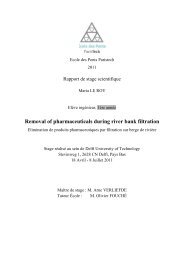
![[pastel-00730831, v1] Incidence des pratiques d'entretien ... - LEESU](https://img.yumpu.com/50938896/1/184x260/pastel-00730831-v1-incidence-des-pratiques-dentretien-leesu.jpg?quality=85)

